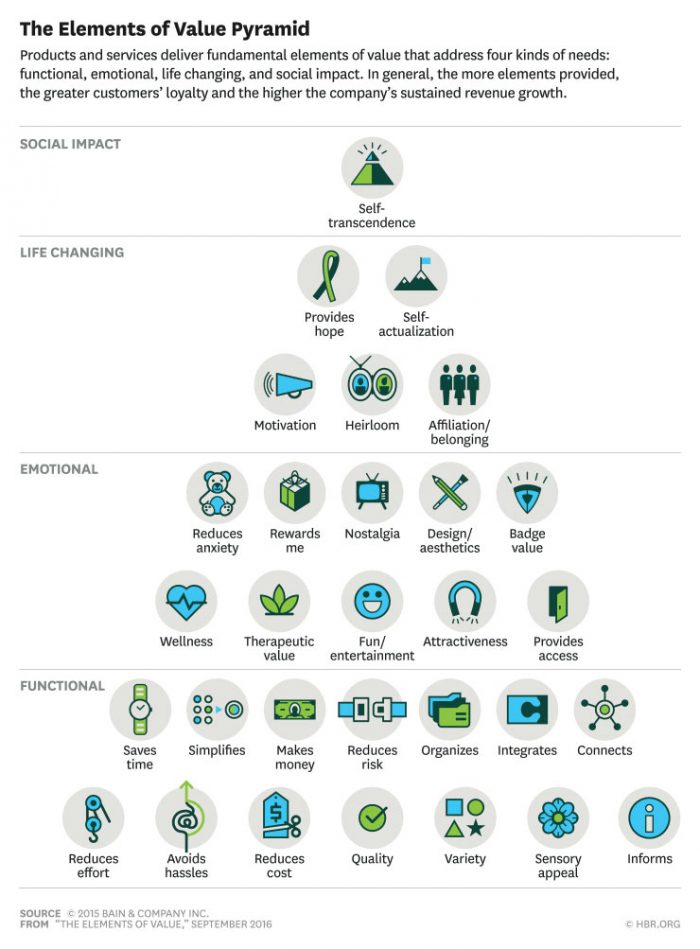
The Elements of Value Pyramid, is decades of research from Harvard Business Review (HBR). They studied thousands of companies. They reviewed vast quantities of consumer research data. And from that, they determined these 30 elemental “building blocks” of value. The implications for businesses are tremendous — from crafting marketing copy to competitive analysis to product design……. and so on…..
What do we mean when we talk about value? When someone is considering purchasing your product or service, they’re weighing the cost you’re asking against the benefits you’re promising.
Is what I’m getting out of this Costa Coffee (an energy boost, a moment of relaxation in the cafe) worth my £4? That’s a question of value.
To drive sales, most of us lower the cost and keep the value the same…….But this pyramid empowers you to keep (or increase) your costs by adding more value.
What are the ways that my products and services are valuable that I haven’t considered?
How can I highlight those in my marketing messages to increase the perceived value of my product?
How the Elements of Value Pyramid Works
Here are what HBR calls the 30 “elements of value,” organised into an increasingly narrow hierarchy. So, let’s break down the pyramid, shall we?
Level 1: Functional Value
The base level of value, which provides something practical or useful. For example:
Reduces effort – Graze food boxes delivers prepped ingredients for a gourmet meal to your doorstep, so you can open a box and immediately get to work on dinner. Saves time Argos
Saves time – Argos self service pay and collection machines lets you purchase your order and skip the line for the cashier.
Simplifies – The touch screen on mobile and tablet devices, make it so easy to type a note, play angry birds and then watch a YouTube video – all on one interface, no more keypads.
Reduces cost – Ikea family loyalty members enjoy massive savings on millions of their products.
Connects – Facebook’s signup page invites you to “Connect with friends and the world around you.”
Quality – Innocent smoothies and juices promise that their drinks are 100% natural help people live well and die old.
The other functional values include:
- Makes money
- Reduces risk
- Organises Integrates
- Avoids hassles
- Sensory appeal
- Informs Variety
Level 2: Emotional Values
The values in the next level invite us to feel a particular way.
Reduces anxiety – Apple offers a backup to customers so they can stop worrying about losing precious files and family photos.
Rewards me – Nando’s makes frequent customers feel special with “loyalty,” which unlocks free refills, chicken and other perks.
Design/aesthetics – Harrods invites shoppers to relax and feel more sophisticated by creating beautiful, visually inventive store spaces.
Wellness – When Special K cereal touts its “A sugar free crafted mix of multi-grain flakes,” they want to make customers feel good about their health choices.
Badge value – Fitbit fosters personal pride by awarding badges to users who reach major accomplishments, like walking 25,000 steps in a day.
The other emotional values include:
- Nostalgia Therapeutic value
- Fun/entertainment
- Attractiveness
- Provides access
Level 3: Life Changing Values
These values promise a personal transformation of some kind.
Affiliation/belonging – Weightwatchers offers not just a club membership but a community that can grow and shape you.
Self actualisation – X Runner and other extreme races want participants to feel like they’ve reached peak athletic (and personal) performance.
Other life changing values include:
- Motivation
- Heirloom
- Provides hope
Level 4: Social impact
At the top of the pyramid, we’re delivering value not to the individual but to the world at large.
Self-transcendence – TOMS shoes offers value to someone besides the customer by providing a pair of shoes to a person in need for every pair sold.